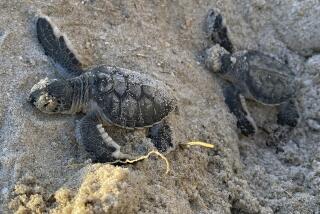‘The problem . . . is that reptiles die very slowly.’
- Share via
The largest turnout that anyone could remember at a monthly meeting of the Valley Chapter of the California Turtle and Tortoise Club tested the capacity of the group’s Woodland Hills gathering place last week.
About 60 turtle owners, accompanied by roughly equal numbers of their turtles and children, filled the community room of Glendale Federal Savings Friday night to learn what makes their babies sick. Their turtle babies, that is.
First, of course, they patted each others’ turtles, shared turtle news and appealed for hatchlings to give out for adoption.
A woman in a lavender velure outfit brought two baby tortoises in a box.
“Ahhh,” everyone said, passing them around and stroking them.
The woman apologized over and over because they hadn’t been bathed.
After the minutes and treasurer’s report, club President Marc Graff, who is a human doctor, introduced the speaker, Ted Adler of Chatsworth, one of about 50 Southern California veterinarians who sees turtles.
Adler, tall, soft-spoken and slightly rangy with long black hair, gave a memorable briefing on the state of internal turtle medicine. Adler demonstrated a turtle checkup, described the symptoms and treatment of the turtle equivalent of a cold, and went into detail on a couple of characteristic turtle ailments such as hyperuricemia, which is caused by too much protein in the diet.
For a finale, he showed a set of color slides of a two-hour operation in which he removed a large bladder stone from a desert tortoise named Claudia.
The domestic turtle, as one can easily see from all this, does not strictly live up to its reputation for hardy self-sufficiency and long life.
“The problem with reptiles,” Dr. Adler observed matter-of-factly at one point, “is that reptiles die very slowly.”
In other words, underneath its shell, an outwardly healthy-looking turtle could be wasting away for years while its owner suspects nothing.
Take the common runny nose. It’s epidemic these days, Adler said. And, in a turtle, it’s always treacherous because it can easily lead to pneumonia. Fluid on a turtle’s lungs is tough to beat.
“They don’t cough very well,” Adler said. “They don’t have a diaphragm.”
Adler treats turtle infections with antibiotics. First, he has to find out what kind of bacteria it is. To do so, he takes a swab from inside the mouth.
And, how do you get a turtle to say ahh ?
“Well, it’s hard,” Adler said.
But a slide showed that it can be done. The hard part is keeping the head out of the shell. That is accomplished by gripping the neck.
Tough cases call for X-rays. Adler showed several and told how he interprets them. Large black spots under the the shell indicate healthy lung tissue. Encroachment of white means pneumonia. Too much white is fatal, Adler said.
Also useful is a blood test. Adler said he usually gets the blood by clipping the end of a turtle’s toenail and draining it.
A few grams of blood suffice to generate a page-long computer printout from which the doctor can judge the function of the heart, the kidney and the liver, and the levels of things like uric acid.
An elderly couple in the front row said they were familiar with the computer printout. They were vacationing in Indonesia when their 17-year BVT, Baron von Turtle, took sick and died.
Their daughter sent along BVT’s blood analysis.
“The people in that country couldn’t believe it,” the woman said. They told her that people in Indonesia don’t get that much information from a blood test.
Adler showed the printout for Claudia, the tortoise he operated on. The X-rays showed several eggs and a dense white mass the size of a fist that seemed to be preventing Claudia from laying.
The tip-off was on her blood test--a uric acid reading of 9. It told Adler that the white mass was a bladder stone. Surgery was Claudia’s only hope.
The next sequence of shots showed Claudia being anesthetized in a Plexiglas box, then intubated and scrubbed, belly up on a table.
Adler said he studied the X-ray carefully for the critical step, measuring the size of the opening so the stone would fit through.
“You can only cut the hole once,” he said.
He cut a square most of the way through with a saw made for removing casts, then finished with a tiny precision saw, leaving one side hinged.
The shell opened like a flap. Careful incisions allowed the removal of the eggs and the stone, which measured about four inches.
Adler tacked the shell flap in place with Superglue and filled the gap with resin and reinforced the shell with fiberglass epoxy. Bondo had proved unsuccessful, he said.
Questions tended toward the practical. Someone asked what the operation cost.
Claudia’s human “mother,” who was in the back, said Adler charged her only $200 because the technique was developmental.
The woman in front said BVT’s last illness cost $500.
“When you have a pet for 60 or 70 years, and it passes through the family, it merits that kind of care,” Adler said.
Someone else asked what Claudia was doing to prevent another stone.
Adler said she was following a careful diet and taking a pill once a day.
And how do you give a tortoise a pill?
“It’s hard,” Adler said. “But you tell her, ‘This is good for you. You’ve got to eat this or you’re going to die.’ ”
More to Read
Sign up for Essential California
The most important California stories and recommendations in your inbox every morning.
You may occasionally receive promotional content from the Los Angeles Times.














